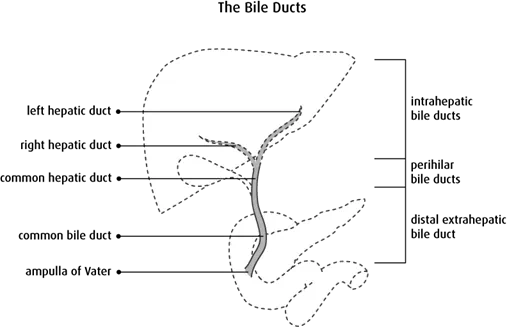Cancerous tumours of the bile duct
A cancerous tumour of the bile duct can grow into and destroy nearby tissue. It can also spread (metastasize) to other parts of the body. Cancerous tumours are also called malignant tumours. Most bile duct cancers start in the epithelial cells that form the lining inside the bile duct. The bile duct cancers that start in the epithelial cells are called cholangiocarcinomas.
Based on how the tumours look under a microscope, bile duct cancers are divided into many different types. Most bile duct cancers start in the gland cells and are called adenocarcinomas. Bile duct cancers are further grouped based on whether they start in the bile ducts outside the liver (extrahepatic) or inside the liver (intrahepatic). Most start outside the liver.
Bile duct cancers are also divided into 3 groups based on their appearance and the pattern of growth:
- Mass-forming bile duct cancer grows outward from the bile duct. It may also be called nodular or exophytic bile duct cancer.
- Periductal-infiltrating bile duct cancer grows along the bile ducts. It may also be called infiltrating or sclerosing bile duct cancer.
- Intraductal-growing bile duct cancer grows into the lumen or space within the bile duct. It is sometimes called papillary or polypoid bile duct cancer.
Extrahepatic bile duct cancer
Extrahepatic bile duct cancer can start in hepatic bile ducts outside the liver or the common bile duct outside the liver.
Extrahepatic bile duct cancers may be perihilar or distal.

Perihilar bile duct cancer starts just outside the liver in the hilum. The hilum is where the hepatic ducts leave the liver and join to form the common hepatic duct. These cancers are also called Klatskin tumours and proximal or hilar bile duct tumours.
About 50% of bile duct cancers are in the perihilar area. This is the most common location.
Distal bile duct cancer starts in the distal area (close to the small intestine). This is the 2nd most common location.
Over 90% of extrahepatic bile duct cancers start in gland cells that line the inside of a bile duct. This type of cancer is called adenocarcinoma of the bile duct.
Adenocarcinomas are grouped into different subtypes:
- adenocarcinoma, biliary type
- adenocarcinoma, gastric type
- adenocarcinoma, intestinal type
- clear cell adenocarcinoma
- mucinous adenocarcinoma
- signet ring cell carcinoma
Other types of bile duct tumours include:
- adenosquamous carcinoma
- intraductal papillary neoplasm with associated invasive carcinoma
- mucinous cystic neoplasm with associated invasive carcinoma
- squamous cell carcinoma
- undifferentiated carcinoma
- neuroendocrine tumours and carcinomas
- sarcoma
- lymphoma
Ampullary carcinoma starts in the ampulla of Vater, where the bile duct empties into the first part of the small intestine. It is a very rare type of bile duct cancer.
Intrahepatic bile duct cancer
Bile duct cancer that starts in a hepatic bile duct inside the liver is called intrahepatic bile duct cancer. This type of cancer may also be called intrahepatic cholangiocarcinoma (ICC). Intrahepatic bile duct cancer makes up about 10% of all bile duct cancers. It is less common than extrahepatic bile duct cancer. The risk of getting intrahepatic bile duct cancer is increased if you have a hepatitis C infection, parasitic infections such as liver fluke, bile duct stones, cirrhosis of the liver or primary sclerosing cholangitis.
Intrahepatic bile duct cancers are grouped into the following subtypes, among others:
- conventional type (bile duct type) adenocarcinoma
- small bile duct type (peripheral type)
- large bile duct type (perihilar type)
- bile ductular type
- intraductal type
- rare types such as squamous, adenosquamous, mucinous, signet ring, clear, undifferentiated and lymphoepithelial
- combined hepatocellular-cholangiocarcinoma
